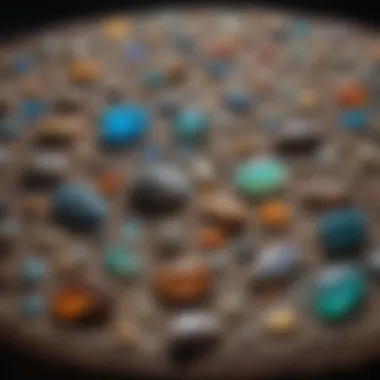A Collector's Guide to Selling Opal: Expert Strategies and Insights


Rock and Fossil Identification
When it comes to identifying rocks and fossils, understanding the different types is crucial for collectors. Rocks can range from sedimentary to igneous to metamorphic, each with distinct characteristics and formations. Fossils, on the other hand, present a glimpse into prehistoric life, with various types such as vertebrate, invertebrate, and plant fossils. To differentiate between these, collectors must look for key characteristics such as color, texture, hardness, and any visible structures.
To aid in identification, utilizing tools like magnifying lenses, geology hammers, and UV lights can enhance the viewing experience. These tools allow collectors to examine rocks and fossils closely, revealing hidden details that might determine their rarity or significance.
Collecting Tips and Techniques
For rock and fossil collectors, adopting best practices is essential to ensure a successful and enjoyable collecting experience. Identifying prime collecting sites involves conducting thorough research on geological maps, regions rich in certain types of rocks or fossils, and seeking permissions for access in protected areas. Furthermore, employing safety measures when extracting specimens, such as wearing safety gear like helmets and goggles and using proper tools, safeguards collectors against potential risks.
To enhance the preservation of collected specimens, employing various techniques is paramount. This includes cleaning rocks and fossils gently using soft brushes or water-based cleaning solutions to avoid damage. Proper storage methods, such as using acid-free boxes or display cases with UV protection, help prevent deterioration over time. Additionally, implementing creative display ideas, like shadow boxes or rotating exhibits, can showcase collections in an aesthetically pleasing and informative manner.
Geological Insights
Delving into the geological aspects of rock and fossil collecting unveils a rich world of formations and processes that have shaped our planet over millions of years. Understanding geological formations, such as sedimentary layers or volcanic deposits, provides insight into the environments in which rocks and fossils formed. Exploring the historical significance of certain specimens, like fossils of ancient creatures or rocks from significant geological events, offers a deeper appreciation for the earth's geological history.
Moreover, acknowledging notable discoveries in the field highlights the contributions of pioneering collectors and scientists to advancing our knowledge of rocks and fossils. Such discoveries not only expand our understanding of the past but also spark curiosity and inspire future generations of rock and fossil enthusiasts.
Understanding Opal
Understanding opal is crucial in the realm of rock and fossil collecting. Opal is a captivating gemstone known for its unique properties and stunning color play. In this article, we delve deep into the characteristics and formation of opal to provide rock and fossil collectors with valuable insights. By understanding opal, collectors can better assess the value of their specimens and navigate the market effectively.
Opal Characteristics
Color Play
Color play is a defining feature of opal that sets it apart from other gemstones. The mesmerizing display of colors, known as play-of-color, is a result of the diffraction of light within the microstructure of the stone. This phenomenon creates iridescent flashes and patterns that make opal highly sought after among collectors. The distinctive blend of hues and the way they interact under different lighting conditions make color play a captivating choice for enthusiasts.
Transparency
Opal's transparency, or lack thereof, plays a significant role in its overall appeal. Some opals possess a transparent or translucent quality, allowing light to penetrate the stone and enhance its colors. On the other hand, opaque opals with a milky appearance also hold a unique charm. The level of transparency can influence the value of an opal specimen, with varying preferences among collectors for different types of transparency.
Varieties


Opal exhibits a wide range of varieties, each with its own distinct characteristics. From precious opals like black opal and fire opal to common opals such as white opal and boulder opal, the diversity in opal varieties caters to diverse collector preferences. Each variety offers a different color play, pattern, and geological origin, adding depth to opal collections. Understanding the various opal varieties allows collectors to expand their knowledge and appreciate the full spectrum of this mesmerizing gemstone.
Opal Formation
Geological Processes
Opal formation is a result of intricate geological processes that occur over millions of years. Opal is typically formed in areas where ancient geothermal hot springs once existed, allowing silica-rich water to seep into rock crevices and solidify over time. The unique combination of temperature, pressure, and mineral content dictates the formation of opal with its distinct properties. By delving into these geological processes, collectors can gain a deeper appreciation for the natural forces that shape opal specimens.
Unique Properties
Opal's unique properties extend beyond its visual appeal to encompass its physical and metaphysical qualities. Opal is known for its ability to diffract light and display a full spectrum of colors, making it a symbol of creativity and inspiration. Additionally, opal is believed to have healing properties and can enhance emotional well-being. Exploring these unique properties adds a layer of mystique to opal collecting, elevating it from a hobby to a meaningful pursuit enriched by the stone's metaphysical allure.
Assessing Opal Value
Assessing Opal Value plays a crucial role in the realm of rock and fossil collecting. This section delves deep into the intricate process of evaluating opals, providing collectors with essential knowledge to determine the worth of their geological treasures. By understanding the various factors that contribute to opal value, collectors can make informed decisions when selling their prized specimens.
Factors Affecting Value
Color Intensity
Color intensity is a pivotal aspect when assessing opal value. The vibrancy and richness of colors within an opal significantly impact its overall worth. Intense colors like vivid reds, blues, and greens are highly coveted in the market, fetching premium prices due to their rarity and visual appeal. However, it's essential to note that color intensity can vary based on factors such as the opal's origin and formation. Collectors should carefully inspect the color saturation to determine the opal's value accurately.
Pattern
The pattern exhibited in an opal also plays a critical role in its value assessment. Intriguing patterns like harlequin, pinfire, and broad flash enhance the opal's allure, making it more desirable among collectors. Opals with distinct and visually appealing patterns command higher prices in the market, reflecting the craftsmanship of nature's artistry. Understanding different pattern variations and their effects on value empowers collectors to showcase the uniqueness of their opals to potential buyers effectively.
Clarity
Clarity refers to the transparency and clearness of an opal, influencing its overall value. Opals with high clarity levels, devoid of inclusions or imperfections, are prized for their purity and brilliance. While some collectors appreciate the mystical quality of included opals with unique formations, clarity remains a significant factor in determining value. Evaluating an opal's clarity involves examining any internal flaws or blemishes that may affect its visual appeal and marketability. Balancing clarity with other value factors is essential for collectors aiming to maximize the selling potential of their opals.
Preparing Opal for Sale
In the realm of selling opal as a rock and fossil collector, preparing the gemstone for sale is a critical step that can significantly impact the success of the transaction. This section delves deep into the nuances of prepping opal specimens for the market, emphasizing the importance of presentation and quality maintenance.
Cleaning and Polishing


Gentle Techniques
When it comes to cleaning opal for sale, utilizing gentle techniques plays a pivotal role in ensuring the gemstone's integrity and visual appeal. Gentle techniques involve using mild cleaning agents and soft brushes to avoid damaging the opal's delicate structure. By being gentle during the cleaning process, collectors can maintain the opal's natural beauty and prevent any unwanted abrasions or scratches that could devalue the stone. The gentle approach is not only essential for preserving the opal's aesthetics but also contributes to the overall perception of quality and care, which can enhance the stone's market value.
Enhancing Luster
Enhancing the luster of opal is a crucial aspect of preparing the gemstone for sale, as luster plays a significant role in capturing the attention of potential buyers. By enhancing the luster, collectors can highlight the opal's iridescence and color play, making it more visually appealing and desirable. One of the key characteristics of enhancing luster is using specific polishing techniques that bring out the opal's innate sheen and brightness. This method not only elevates the opal's appearance but also adds a luxurious touch, making the gemstone more alluring to prospective purchasers. While enhancing luster enhances the opal's attractiveness, collectors should be mindful of over-polishing, as excessive polishing can diminish the stone's natural charm and uniqueness. Striking a balance between enhancing luster and preserving the opal's authenticity is crucial for successful sales.
Presentation
In the competitive market of selling opal, presentation plays a vital role in capturing the interest of potential buyers and distinguishing one's offerings from others. This section focuses on the strategic aspects of presenting opal specimens effectively to maximize their appeal and attract discerning collectors.
Photography Tips
High-quality photography is essential for showcasing opal's true beauty and capturing its intricate details. Photography tips discussed in this guide include lighting techniques, angles, and backgrounds that can enhance the opal's visual impact in online listings or marketing materials. By implementing these tips, collectors can convey the opal's color play and uniqueness more effectively, enticing prospective buyers and increasing the likelihood of successful sales. The use of professional photography techniques not only elevates the aesthetic presentation of opal but also instills confidence in buyers regarding the quality and authenticity of the gemstone.
Descriptive Listings
Crafting descriptive listings is a fundamental aspect of presenting opal for sale, as detailed descriptions can provide valuable information to potential buyers and convey the opal's individual characteristics. Descriptive listings should include vital details such as color variations, patterns, transparency levels, and any special features that make the opal distinctive. By offering comprehensive descriptions, collectors can educate buyers about the opal's unique qualities and help them make informed purchasing decisions. Additionally, descriptive listings contribute to building trust with customers and establishing credibility as a knowledgeable and transparent seller in the opal market. Effective use of descriptive language and detailed information can set collectors apart in a competitive selling environment, ultimately leading to successful transactions.
Finding the Right Market
In the world of selling opals, finding the right market is crucial to ensure a successful and profitable transaction. Understanding where and how to showcase these unique geological specimens can make a significant difference in attracting the right buyers and obtaining the best value for your opals. Whether you are a seasoned collector or a novice enthusiast looking to sell your opals, selecting the appropriate market is paramount.
Online Platforms
When it comes to exploring online platforms for selling opals, there are various avenues that collectors can explore to reach a wider audience of potential buyers. Online platforms offer convenience, accessibility, and a global reach that can significantly enhance the visibility of your opals in the market.
Auction Sites
Auction sites provide a dynamic and interactive platform for rock and fossil enthusiasts to engage in buying and selling opals. The competitive nature of auctions can drive up prices and create a buzz around your opal listings, attracting serious buyers who are willing to pay a premium for unique specimens. The key characteristic of auction sites is the opportunity they offer for opal collectors to showcase their specimens to a wide pool of interested buyers within a specified timeframe, leading to potentially lucrative sales.
Specialized Forums
Specialized forums cater to a niche audience of rock and fossil collectors who have a specific interest in opals. By engaging with like-minded individuals on these forums, sellers can connect with potential buyers who appreciate the rarity and beauty of opals. The key advantage of specialized forums is the targeted audience they attract, ensuring that your opals are viewed by individuals who have a genuine interest in adding these unique specimens to their collections. Sellers can utilize these forums to share detailed information about their opals, interact with potential buyers, and negotiate directly to secure a sale.


Local Options
In addition to online platforms, exploring local options can also be beneficial for selling opals. Local markets offer the opportunity to showcase your opals in person, interact with buyers face-to-face, and establish personal connections that can enhance the selling experience.
Craft Fairs
Craft fairs provide a vibrant and eclectic setting for showcasing opals to a diverse audience of art and craft enthusiasts. The key characteristic of craft fairs is the festive atmosphere and the opportunity for sellers to engage directly with buyers, share the unique features of their opals, and educate visitors about the geological significance of these specimens. Sellers can leverage the interactive nature of craft fairs to attract attention to their opals, network with potential buyers, and make sales on the spot.
Specialty Shops
Specialty shops dedicated to rocks, minerals, and fossils are ideal venues for selling opals to collectors who appreciate the geological and aesthetic value of these specimens. The key advantage of specialty shops is the targeted audience of rock and fossil enthusiasts who frequent these establishments in search of unique additions to their collections. By partnering with specialty shops, sellers can access a curated market of individuals who are knowledgeable about opals and willing to invest in high-quality specimens. Additionally, the expertise of shop owners and staff can help sellers showcase their opals effectively, provide valuable insights to potential buyers, and facilitate smooth transactions.
Negotiating and Closing the Sale
In the realm of selling opal, the phase of negotiating and closing the sale holds paramount significance. This critical stage encapsulates the culmination of efforts put into valuing the opal, finding the appropriate market, and now, reaching an agreement with potential buyers. Negotiating skillfully can mean the difference between a satisfactory transaction and a missed opportunity. Initially, it is essential to establish a base price that serves as a starting point for negotiations. Utilizing flexible approaches can cater to diverse buyer preferences, potentially leading to a mutually beneficial deal. Emphasizing clear communication is key during negotiations, ensuring all terms and conditions are understood by both parties. The art of negotiating and closing the sale lies in striking a balance between securing a fair price for the opal and fostering positive relationships with buyers. Mastering this stage is fundamental for rock and fossil collectors looking to monetize their opal specimens effectively.
Conclusion
The Conclusion section of this comprehensive guide on selling opal to rock and fossil collectors plays a vital role as it ties together all the crucial aspects discussed in the article. It serves as a summation of the insights provided throughout the guide, offering a final perspective on the process of selling opal. By delving into the key points highlighted in each preceding section, the Conclusion brings closure to the journey of understanding the value and market dynamics of opal sales. It acts as a compass for collectors, guiding them on how to navigate the complexities of the market and make informed decisions regarding their prized geological specimens.
In this article, the Conclusion encapsulates the essence of the opal selling process, emphasizing the importance of thorough preparation, market awareness, and strategic negotiation. It underscores the significance of leveraging market trends and assessing opal value accurately to maximize sales opportunities. The Conclusion also sheds light on the necessity of continuous learning and adaptation in the ever-evolving market landscape, urging collectors to stay informed and proactive in their selling endeavors.
Moreover, the Conclusion serves as a motivational tool for collectors, instilling confidence in their ability to sell opal successfully. It provides encouragement to delve deeper into the world of opal sales, armed with the knowledge and strategies outlined in this guide. By highlighting the practical insights and expert tips shared in the various sections, the Conclusion empowers collectors to approach the selling process with clarity, confidence, and purpose.
Final Thoughts
Impact of Opal Sales
The Impact of Opal Sales is a pivotal aspect within the realm of selling opal to rock and fossil collectors. It signifies the ripple effect that opal sales can have on both individual collectors and the broader market. One key characteristic of the Impact of Opal Sales is its ability to contribute to the preservation and appreciation of geological wonders. By facilitating the exchange of opal specimens among collectors, this dynamic impact nurtures a community of enthusiasts dedicated to showcasing the beauty and diversity of opal specimens.
Participating in opal sales not only enriches collectors' portfolios but also fosters a sense of camaraderie and camaraderie among like-minded individuals. The uniqueness of opal specimens fuels a sense of discovery and admiration, driving the passion for opal collection forward. While engaging in opal sales offers rewarding experiences and opportunities for expansion, it also comes with the challenge of navigating a competitive market landscape and evolving consumer preferences.
Despite some variations in market demand and pricing, the Impact of Opal Sales remains a popular choice for collectors seeking to showcase their geological treasures and engage in meaningful exchanges within the collecting community. Its inherent appeal lies in the intrinsic value of opal specimens and the potential for collectors to uncover rare finds that enrich their collections. However, collectors must be mindful of market trends and buyer preferences to capitalize on the opportunities presented by opal sales successfully.
Continuing Your Collection Journey
Continuing Your Collection Journey marks a significant phase in the opal selling process, as it encourages collectors to view their sales experiences as part of a broader exploration of the geological world. This aspect contributes to the overall goal of enhancing collectors' knowledge and passion for opal specimens, extending beyond the transactional aspect of selling. A key characteristic of Continuing Your Collection Journey is its emphasis on lifelong learning and curiosity, propelling collectors to deepen their understanding of opal characteristics and origins.
By embarking on a continuous collection journey, collectors immerse themselves in the wealth of geological wonders that opal offers, fostering a sense of appreciation and wonder for the natural world. This ongoing exploration allows collectors to cultivate a discerning eye for opal specimens, recognizing unique features and qualities that add value to their collections. While the journey may present challenges and uncertainties, it also opens doors to new discoveries and connections within the collector community.
The unique feature of Continuing Your Collection Journey lies in its transformative potential, shaping collectors' perspectives and enriching their experiences in the world of opal sales. By embracing the journey as a continuous learning process, collectors embrace growth, resilience, and adaptability, key traits that contribute to long-term success in opal sales. However, this journey also requires dedication, patience, and a willingness to explore new avenues of learning and engagement to fully reap the benefits of a thriving opal collection.







